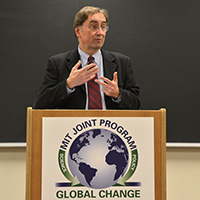
Mark Dwortzan | MIT Joint Program on the Science and Policy of Global Change
At the recent U.N. climate talks in Paris, national governments weren’t the only entities asked to do their part to help cap the rise in average global temperature since preindustrial times to 2 degrees Celsius. So, too, were so-called “non-state actors” such as NGOs and industry leaders, who along with national representatives, were urged to form partnerships and increase climate action in a process called the Action Agenda. The goal: to launch a virtuous cycle of climate action, where demonstration of action on the ground encourages negotiators to make more ambitious pledges, which, in turn, generate even more action.
In a lecture hosted by the MIT Joint Program on the Science and Policy of Global Change on March 2, Janos Pasztor, Senior Advisor to the U.N. Secretary-General on Climate Change, described the U.N.’s Action Agenda from its origins to its emergence at COP21 to its next steps. Pasztor, who received his M.S. and B.S. degrees at MIT, has spent the past 35 years working for various U.N. and non-governmental organizations on issues of energy and environment, with an increasing focus on climate change. His previous U.N. appointments include Assistant Secretary-General on Climate Change, and Director of the Secretary-General’s Climate Change Support Team.
Origins
Pasztor noted that until recently, U.N. climate negotiations—starting with the UN Framework Convention on Climate Change in 1992 and continuing with the annual Conference of the Parties (COP)—were largely limited to U.N. officials and national government representatives.
“It’s all the same people. They talk to each other, some of them get promoted, they go into the [U.N.] Secretariat, some of them go from the Secretariat back to countries and they become delegates,” he observed. “There [was] this sense that climate change links to everything, everything impacts climate change, and the negotiations are isolated.”
Recognizing that much of the action that was necessary to stabilize the global climate was beneath the national government level, U.N. Secretary-General Ban Ki-moon invited heads of state as well as business, finance, civil society and local leaders to a Climate Summit in New York City in September 2014. Its objective was to identify shining examples of concrete actions in climate mitigation, adaptation, finance and other domains, and then import those examples into the negotiation process.
“The hope was that this would create a kind of virtuous circle,” Pasztor explained, “because if there is recognition by the negotiators that there is action already on the ground, then it would be easier for them to come to more ambitious agreements, and if they come to more ambitious agreements, then there will be even more action on the ground.”
The summit resulted in many new initiatives, including the New York Declaration on Forests, a pledge by more than 150 partners from government, industry and civil society to halve the rate of deforestation by 2020 and to end it by 2030; a commitment by the world’s largest food retailers to change their supply chains to reduce emissions and increase resilience; and promises from firms in the finance sector to shift billions of dollars of assets from high to low-carbon investments.
Bringing the Action Agenda to COP21
The summit also led to the first COP-level discussion of the Action Agenda at COP20 in Lima in December 2014, and a commitment to bring that agenda to the COP21 Paris climate talks one year later. Coordinated by the U.N. Secretary-General, the Executive Secretary of the UNFCCC and the presidents of Peru and France, this pledge became known as the Lima-to-Paris Action Agenda.
Each of the four parties, in collaboration with multiple stakeholders from the private sector and civil society, oversaw one or more of 12 work streams on energy efficiency, renewable energy, agriculture, transport, short-lived climate pollutants, forestry, resilience, cities and regions, innovation, buildings, business and private finance. They agreed that actions in these domains must be ambitious (consistent with capping the rise in average global temperature since pre-industrial times to 2 degrees Celsius); collaborative (preferably involving multiple stakeholders); aligned with the U.N.’s sustainable development goals; and transparent.
At the Paris Climate talks in December 2015, developments in all 12 work streams of the Lima-to-Paris Action Agenda were presented and discussed in full or half-day meetings that drew delegates from civil society and the private sector, as well as the U.N. Secretary General and French President Hollande. The meetings not only demonstrated specific actions on the ground but also produced many new commitments—all integrated into the 188 Nationally Determined Contributions to the Paris Agreement.
“It was amazing to see the mixture of private sector and NGO delegates all sitting there and exchanging about action, and you could really feel that Isolation was no longer the reality,” said Pasztor. “We have collectively managed to achieve a situation where all this incredible action and development that is taking place outside of the negotiation process has now found a way into the negotiation process. I think that’s a very positive development, and we will really see the positive results of this over time.”
As climate negotiators anticipate the 22nd Conference of the Parties (COP22) in Marrakesh, Morocco, the Action Agenda continues to grow, as more non-state actors join in.
The event was cosponsored by the MIT Joint Program, the MIT Energy Initiative, the MIT Environmental Solutions Initiative, the MIT Office of the Vice President for Research, The MIT Center for Collective Intelligence, the Climate CoLab and the MIT Sloan School of Management, the MIT Sloan Sustainability Initiative.
See video of the event here.
Photo: Janos Pasztor, Senior Advisor to the U.N. Secretary-General on Climate Change

